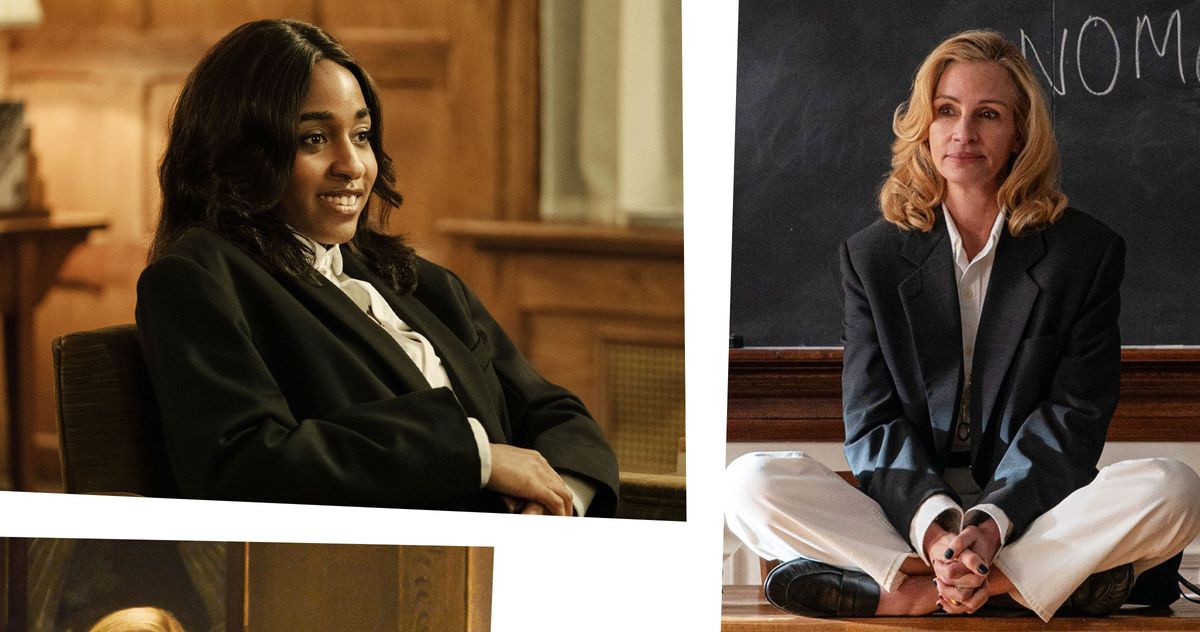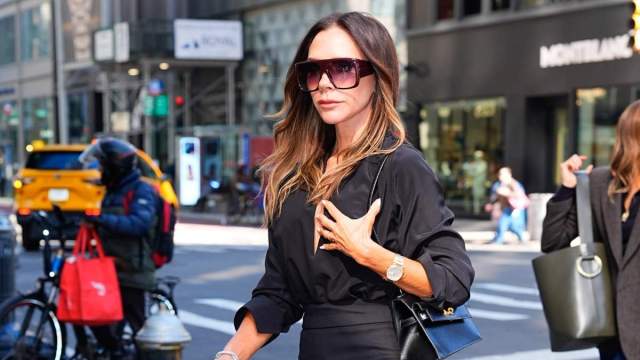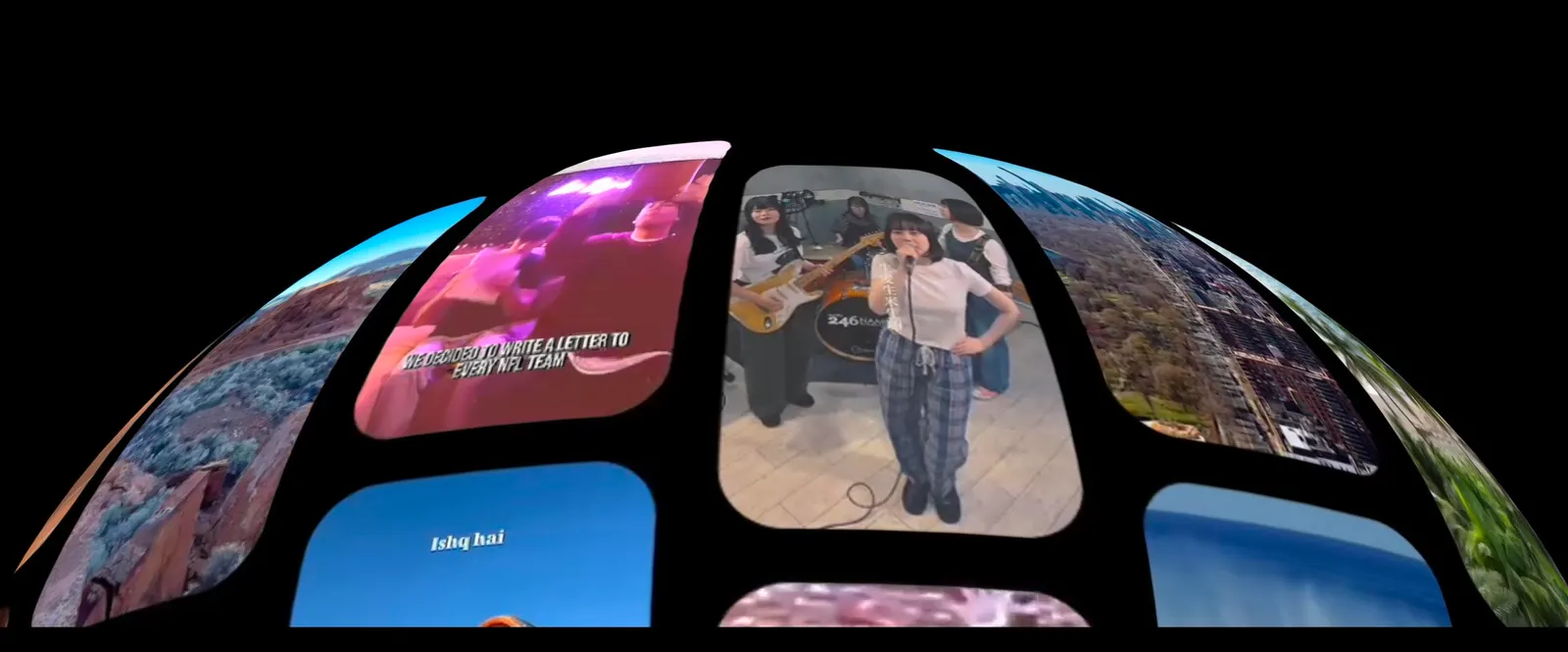Photo-Illustration: by The Cut; Photos: Yannis Drakoulidis /© Amazon MGM Studios / Courtesy Everett Collection
Luca Guadagnino’s After the Hunt — the quasi–Me Too movie set on the Yale University campus and starring Julia Roberts, Chloë Sevigny, Ayo Edebiri, and Andrew Garfield — gives professorial style a stylish upgrade, one without the standard tweed and plaid and dusty elbow patches.
Costume designer Giulia Piersanti uses the film’s androgynous wardrobe to toy with gender roles and tests the limits and expectations of power. “Gender doesn’t usually interest me in the sense that either works for all,” Piersanti says, “and I like the line to stay blurred.” As Conclave made “quiet luxury” akin to godliness, After the Hunt delivers defensive fashion in the form of black blazers, white denim, and solid crewnecks — a look that, as Piersanti puts it, blurs the lines between the ethics of male-female, student-teacher power dynamics outside the classroom. Take Roberts and Garfield, playing Ivy League professors, who flirt as colleagues by dressing alike in almost identical tumbled-blue denim button-ups. Edebiri, playing a grad student and protégé to Roberts’s Alma, makes fashion a weapon of an unrequited crush: Her donning a long necklace over a standard tee tucked into white denim pants under an oversize black blazer with matching loafers mirrors Alma’s ensemble, a move to intimidate her boss as a blackmail ploy dressed up as a love letter. Copying is the highest form of flattery, after all. A hazy scene in which the Yale crew are at Alma’s house to fraternize as a department, overpoured wineglasses in hand, is basically just an assembly line of blazers. It would be comical if it wasn’t so chic.
“All the characters of the film have the same ingredients,” Piersanti says, “blazers, loafers, jeans, button-downs. They just have different tastes, fit, and are styled differently to tell their different personalities.”
The timelessness of intellectual East Coast upper-class fashion makes being rich look easy and being right look dangerous. And the casual daywear delivers both narrative and literal layers. The controlled ease of this aesthetic undercuts the heaviness of the film (cancel culture! Assault allegations! The intersection of misogyny and racism!) while still feeling lived in and accessible. After the Hunt does for denim what Tár did for tailored suiting, covertly using fashion to speak to the interchangeability of gender roles within the power structure of performative masculinity.
It’s all the handiwork of Piersanti, also a knitwear designer. Piersanti has had stints at Balenciaga, Lanvin, Dior, and Missoni before becoming the head of knitwear at Celine. She first collaborated with Guadagnino exactly a decade ago with 2015’s A Bigger Splash; her other Guadagnino credits include Call Me by Your Name, Suspiria, Bones and All, and the HBO Max limited series We Are Who We Are. “I don’t think any project I have done with Luca is the same,” she says. “He is so diverse in the projects that he gets passionate about, and the way he involves you in them is truly inspiring.”
Below, Piersanti tells us about reuniting with Guadagnino and how Joan Didion, Diane Keaton, and even David Lynch inspired the looks for After the Hunt.
What real-life inspirations did you have in mind for After the Hunt’s costumes? There are a few looks right out of Gwyneth Paltrow’s ski-accident testimony …
My mood boards were filled with the women I get inspired by, whose style is so subtle and effortless that it never passes. Women like Carolyn Bessette, Joan Didion, Diane Keaton, Camilla Nickerson, Sade, and more — even Julia Roberts herself. There was a time where specifically, Julia was in the street somewhere and was wearing simply a blazer, white T-shirt, jeans, and white sneakers. That became a central inspiration. Also, the ones where she is wearing a navy pin-stripe suit with her beautiful haircut holding her Golden Globe.
Edebiri re-created that look on the red carpet once …
Exactly. It was that one. For the men of the film, I looked at a young Harrison Ford and Paul Auster for Hank (Garfield) and Philip Glass and David Lynch for Frederik (Michael Stuhlbarg).
How did you decide on the white denim, black loafers, and black blazer look worn by both Roberts and Edebiri? Do you anticipate that being a look audiences will copy?
A lot of people have come up to me saying they would like to dress like this. I feel like it is a style that has always been there. I see it in the streets. It is focused, practical, smart dressing that doesn’t fall for trendy.
Roberts’s looks reflect the “coldness” that her character, Alma, is accused of having. It’s almost like her blazers are part of the façade of masculinity that she’s conveying. That changes later, though, as she softens. How did you chart Alma’s emotional evolution and ethical reckoning through her outfits?
First we see her in the beginning in her white suit, which tells us about her confidence and magnetism. Through the film, her everyday look is casual yet controlled, with only straight, sharp lines — never soft lines — which fall apart at the edges as her life unravels. And in the end of the film, years later, her secret has been revealed and she is finally wearing softer lines like a cozy knit and skirt.
What was your sourcing process? Which brands did you look to?
I specifically chose pieces that didn’t scream brand names as part of the purpose of the film. I often chose pieces for their fabric and how they worked out in the deep, light-absorbing photography of the film. And, of course, how they fit with the characters. I chose brands like The Row, Lemaire, Celine, and Toteme, paired with Ilaria Icardi jewelry and Cartier watches to elevate Alma’s look. The flat shoes and L.L.Bean bag was to add a balance and bring a casual touch.
I did the same for Alma’s husband by replacing the usual idea of a velvet corduroy blazer with elbow patches and putting him instead in Japanese brands like Comoli, Auralee, and Comme des Garçons to elevate him to be the right match to Alma. The specific fabrics Japanese designers use also work great with the lighting of the film.
For the final scene, how reflective was Edebiri’s more colorful outfit of her character Maggie’s changed outlook? It’s almost as though the changes in both Roberts’s and Edebiri’s wardrobes show the growth for both Alma and Maggie, especially since Maggie is no longer copying Alma’s fashion.
Exactly. She has hopefully come to terms with who she is and broken away from Alma.
What is your favorite look in After the Hunt?
Working with Julia Roberts was an amazing experience. She makes everything look so good, and to see her transform into this character who is so opposite from how she is in real life was amazing. Creating her wardrobe was one of my favorites.
What about your favorite look of your career?
I’d say maybe the costumes I made for the witches in the ceremony in Suspiria. They were made of draped human hair. I enjoyed making the costumes for that. I also really enjoyed dressing Fraser, the main character in We Are Who We Are in archive Comme des Garçons and Raf Simons.
I have a few other film projects with Luca next. I am most looking forward to his adaptation of Thomas Mann’s Buddenbrook, which will be my first period experience. [Buddenbrook is described to be a companion film to Queer and was announced in 2024.] Luca has given me so many great projects in which I could find creative expression. I could not be more thankful.


